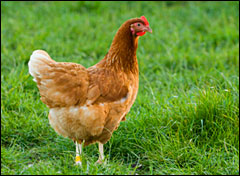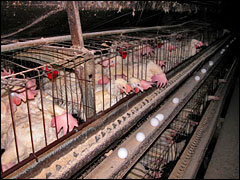You can bet that if all the animals in America had televisions — as they do in San Francisco’s SPCA shelter — they’d be tuned in to California’s election returns on Nov. 4.

A free-range chicken.
On the ballot is an initiative — Proposition 2 — that is as potentially transformational for the treatment of farm animals raised for food in the United States as the presidential vote could be for the nation itself.
Watching closely will be the nation’s big meat and egg producers. Because if Californians embrace Prop. 2 — and scant polling on the initiative suggests it’s a runaway hit — they will be sending a message that goes far beyond the relatively modest changes required by the measure: Consumers really do care about where their food comes from and how it is raised, and they’re willing to set limits even if industry isn’t.
It’s not just another one of those far-out Left Coast things. The Prop. 2 campaign is playing on a mainstream, national stage. Oprah Winfrey devoted a show to the issue of food-animal care and Prop. 2 last week, and the New York Times editorial page voiced support for the proposition.
The changes called for in Prop. 2 are small but significant. The ballot wording says simply that Prop. 2 “requires that calves raised for veal, egg-laying hens, and pregnant pigs be confined only in ways that allow these animals to lie down, stand up, fully extend their limbs and turn around freely.” It would take effect Jan. 1, 2015.
If Prop. 2 passes, its main sponsor, the Humane Society of the United States, expects national reverberations — and has every intention of helping beat that drum.
Says Paul Shapiro, senior director of the Humane Society’s Factory Farming Campaign, “Nobody can ignore the fact that California is the largest agricultural state in the country and it’s often a trendsetting state. We envision national reforms coming from passage of Prop. 2. What happened in the veal and pork industry is evidence of this.”
Since 2002, veal and pork producers have been hit with tighter regulations in Arizona, Colorado, Florida, and Oregon, thanks to new laws outlawing the confinement of veal calves and/or pregnant pigs in crates so small they can’t turn around. These laws have added muscle to the growing consumer push for more humanely raised pork and veal, and producers and retailers have started to respond. Smithfield Foods, the nation’s biggest pork producer, is phasing out gestation crates, metal cages in which many factory farms keep pregnant pigs. The American Veal Association has urged an end to veal crates. Food retailers from Chipotle to Safeway to Burger King have climbed on board, too.
California’s Prop. 2 would prohibit veal and gestation crates as well. But it’s really all about eggs. Prop. 2 takes square aim at the commodified egg industry’s practice of crowding laying hens into small wire cages, stacked to the rafters, in the name of efficiency and profits.
Prop. 2 would not require egg producers to stop caging hens. But they would have to provide enough space in the cages for the hens to do the things that hens naturally do, as defined by the initiative.
The campaign against Prop. 2 says that the measure, however well-intentioned, will be bad for both animals and humans, and could push California egg producers to Mexico, beyond the reach of American food-safety laws.

Caged hens.
Photo: Compassion Over Killing
The industry says cages protect hens from disease and from their tendency to fight. The space standard for a white leghorn is 67 square inches, according to Nancy Reimers, a poultry-industry veterinarian who works for the “No on Prop. 2” campaign. That’s about two-thirds the size of a sheet of printer paper.
Often, though, so many hens are jammed into battery cages that they can’t lay down, let alone flap their wings — if there’s room for them to get their feet on the ground at all. (I’ve never seen this firsthand, but documentary film footage of abuses is widely available online. The latest, shot in August and September, shows carnage inside a facility run by Norco, one of California’s big egg producers. The anti-2 campaign called it “dubious and cynical” pro-2 propaganda.)
Follow the Money
The amount of money involved — more than $6 million on the yes side, more than $5 million for no — tells you there are more than a few omelettes at stake in the Prop. 2 campaign.
The Humane Society has put up more than half the yes campaign’s war chest, with the rest coming from other animal-welfare groups and a colorful list of individuals, including financier T. Boone Pickens and his wife, Houston Rockets owner Leslie Alexander, and cartoonist Patrick McDonnell, whose “Mutts” comic strip featured a Prop. 2 story line this month.
Large egg producers from all over the country have poured money into the anti-2 campaign. Among them are Norco, Moark, and Demler, among California’s biggest players, plus producers in Indiana, Minnesota, Ohio, Pennsylvania, Texas, and many other states. Farm bureau federations from California, Kansas, Tennessee, Texas, and Florida have contributed too.
The names of the competing sides tell you exactly how the debate is being framed: It’s Californians for Humane Farms against Californians for SAFE Food.
Both sides have planted campaign signs on the food-safety lawn, and can produce jousting scientific studies to buttress their claims, but the no side is relying more heavily on safety arguments.
According to opponents, Prop. 2 “jeopardizes our food safety and public health” because eggs are more likely to carry diseases like salmonella if the hens’ carefully calibrated environment is changed. Reimers also says Prop. 2 would kill California’s egg industry, and that would leave Californians dependent on eggs from states or countries that lack California’s food-safety regulations.
Current space allocations for hens, says Reimers, are “based on the best science.”
The yes side points to its own sets of data showing lower rates of salmonella and other bugs that can hurt humans when hens have more space. And it has the support of a number of influential consumer and food-safety groups, including the Center for Food Safety, the Center for Science in the Public Interest, and the Consumer Federation of America.
As far as hen health goes, the no side argues that the hens are safer and more secure separated into small social groups in cages. The yes side has only to show photos of tiny battery cages clogged with feces to make its case that the hens aren’t happy.
The California Veterinary Medical Association, plus 700 individual California vets, support Prop. 2. But nationally, the picture flips: the American Veterinary Medical Association, while officially neutral, says Prop. 2 is “primarily based on emotion” and could have “unintended negative consequences” for hen and human health.
A Penny Here, a Penny There
Opponents of Prop. 2 say it would double egg prices. Proponents say it would raise the price of an egg by only a penny. But the threat of higher prices was enough to win the California NAACP over to the no side.
A July 2008 study from the Agricultural Issues Center of the University of California at Davis projects that Prop. 2 would cause “little, if any, cost increase” for consumers, in large part because it would lead to more eggs coming from out of state. That would deal a lethal blow to California’s $330 million egg industry within five years, the study concluded. Half the eggs consumed in California already come from out of state.
Jennifer Fearing, chief economist for the Humane Society of the United States and Prop. 2 campaign manager, says there’s no way the U.S. egg industry really believes the measure would doom California’s egg producers. If it did, out-of-state egg producers wouldn’t be flooding the no campaign with contributions, she says, because they would only have market share to gain.
“They are worried that this is nailing down the principle that all animals including those raised for food deserve humane treatment,” she says.
The yes side also contends that the U.C.-Davis report ignores the economic upsides of Prop. 2 — that it would help small, family farmers and likely encourage production of cage-free eggs. The study fails to take into account California’s growing market for cage-free eggs, Fearing says, and Prop. 2 could bring prices for them more in line with conventional eggs.
That may be one reason some small producers who have carved a profitable cage-free niche out of the commodity egg market oppose Prop. 2, Fearing says.
One cage-free producer displays a “Californians for SAFE Food” banner on its stall at San Francisco’s Ferry Plaza Farmers Market, arguably one of the nation’s most rarified bastions of local, sustainable, and humanely raised food. Its owner did not return calls asking why, but he’s been quoted as saying that Prop. 2 would kill his business.
Demand for cage-free eggs has already pushed the food industry to start adopting more humane practices when it comes to laying hens. Whole Foods Markets refuses to sell eggs from caged hens, and Safeway and Burger King have taken incremental steps toward selling or using more cage-free eggs.
The Winds of Change
However the economics play out, it seems likely that come Nov. 4, powerful winds of change will be blowing out of the West and into henhouses across the nation. Voters like Prop. 2, according to a poll conducted by four California TV stations in late September. It showed strong support among likely voters, 72-10 with 17 percent undecided — though that was before late-campaign ad blitzes for both sides.
Peter Singer, the animal rightist and Princeton professor, told me by email that Prop. 2 is “enormously important — the most important popular vote for animals in the history of the United States, I’d say.”
“Yes, it’s a small step, but factory farming isn’t small — it affects billions of animals each year, in the U.S. alone,” Singer wrote. “If California follows Arizona and Florida in voting against factory farming, it will be impossible to deny that the American public, given a chance to express their views, is against the close confinement of animals, which has been a standard feature of U.S. animal production for the past 50 years. And that will send a signal to producers that they had better change their ways, or they will be put out of business.”
Michael Pollan, the U.C.-Berkeley journalism professor whose book The Omnivore’s Dilemma propelled him to leadership of the movement to reform the U.S. food industry, says he signed the petition to get Prop. 2 on the ballot, though he does expect it to have unintended consequences, perhaps even negative ones for California egg producers.
He adds, “My hope is that, as on so many issues, California will push the rest of the country forward, and Prop. 2’s passage will push companies like McDonald’s to change their standards (they’re on the precipice already, I’m told) and California’s position will become the de facto national position. So whatever messiness we may inherit here, California will, when the history of these brutal practices is written, look visionary.”
Watch the Campaign Ads
Yes on Prop. 2:
No on Prop. 2:
Watch an interview with Prop. 2’s campaign manager
Jennifer Fearing, chief economist for the Humane Society of the United States, is serving as the Prop. 2 campaign manager. She discussed the initiative earlier this year with Grist’s Tom Philpott.


